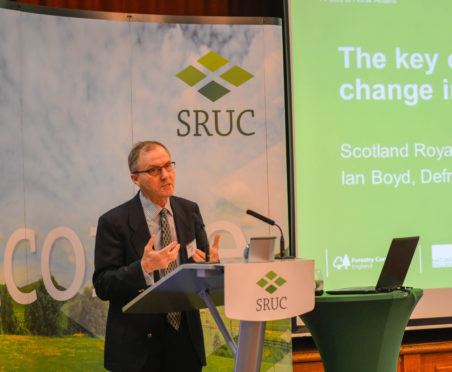A key Defra civil servant painted a bleak picture of a broken and inefficient British farming system, then outlined the challenges of designing new policy which would create a better future for the industry.
At a conference on the future of rural communities in Scotland and Ireland, Professor Ian Boyd, chief scientific adviser at Defra, told Scotland’s agricultural elite that farmers faced environmental, productivity and social challenges which required the sector to be reimagined in a “very, very different form” in future.
He said: “We have three key challenges.
“One is around a social challenge which is about keeping people on the land because we have cultural heritage we want to maintain.
“But we also have a productivity challenge and certain parts of the farming sector will be asked to step up to deliver that.
“And then there’s an environmental challenge, and that cuts across all aspects of farming in some way or another.”
Referring to environmental pressures on the industry, he pointed out the inefficiencies and unsustainability of current systems and added: “We are nowhere near ambitious enough in asking what farming is going to look like in one or two generations’ time, because it cannot look like it does now.”
Prof Boyd went on to warn that stakeholder expectations of post-Brexit policy were incompatible with the likely outcome.
“In the discussions that are going on around a replacement for the Common Agricultural Policy in England, everyone thinks they are going to get something positive out of it and actually I don’t think that’s possible. Some people are going to be losers and some are going to be winners,” he said.
“The question is how are you going to compensate the losers.”
Prof Boyd spelled out the industry’s reliance on direct payments and its vulnerability to volatile markets and exchange rates and said the challenge for policy was to develop a system by which farmers who were unprofitable could be moved into a “profitable state of business”.
Some parts of the industry would need support, and it was important that farmers were given time to adapt to the changes they faced.
He said he wasn’t responsible for making policy, but nevertheless went on to describe what he thought “might work”.
“We need clear and balanced objectives, transition over time to allow social adaptation. We need to make hard choices. We need a system of support that is sensitive to sector ambitions and to geography: there are certain parts of the country, like Scotland and Ireland or the north of England, where different sorts of support will be needed relative to say Lincolnshire or East Anglia.”
He added: “We need to reward outcomes, not inputs.”
nnicolson@thecourier.co.uk






